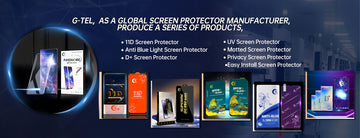How to Remove a Screen Protector: A Step-by-Step Guide
How to Remove a Screen Protector: A Step-by-Step Guide
Over time, screen protectors can become scratched, worn out, or start peeling off on their own. When that happens, it's important to remove them properly so you can apply a new one or simply enjoy a fresh, unprotected screen. While removing a screen protector might seem like a simple task, doing it incorrectly could cause damage to your phone’s screen or leave behind sticky residue. In this guide, we’ll walk you through the steps of safely and effectively removing a screen protector from your smartphone.
What You’ll Need:
- A flat, clean surface
- A plastic card or thin tool (such as a plastic spatula)
- Isopropyl alcohol (optional, for cleaning any residue)
- A microfiber cloth
Step-by-Step Guide to Removing a Screen Protector
1. Prepare Your Workspace
Start by finding a clean, flat surface to work on. Ideally, you should remove the screen protector in a space where you won’t be interrupted. If you have a tempered glass screen protector, handle the process carefully to avoid any sharp edges.
2. Turn Off Your Phone
Before you begin, always turn off your phone to prevent any accidental touches or screen input during the process. This ensures both your safety and the integrity of your phone.
3. Examine the Edges of the Screen Protector
Look at the edges of the screen protector to see if it's already peeling off or if you can easily get a grip on one corner. Many screen protectors will begin to peel at the edges after regular use, making it easier to start the removal process.
4. Lift the Screen Protector
Using your fingernail or a plastic card, gently lift one of the corners or edges of the screen protector. Start slowly and be patient, as trying to yank the protector off too quickly could result in cracking the tempered glass (if you have a glass protector) or leaving sticky residue behind (if you have a plastic film protector).
- Tip: If the screen protector is difficult to lift, you can apply a bit of heat from a hairdryer for 10-15 seconds. This can soften the adhesive and make it easier to peel off. Just be careful not to overheat your phone.
5. Peel the Protector Off Slowly
Once you’ve lifted the corner, continue to peel the screen protector off by slowly pulling it away from the screen. Do this gently to avoid any damage to the screen underneath. If you’re using a plastic film screen protector, it should peel off relatively easily. For tempered glass protectors, you may need to apply a little more pressure, but make sure to pull evenly to avoid cracking it.
6. Clean the Screen
After successfully removing the screen protector, your phone’s screen might have some adhesive residue left behind. To clean this off, use a microfiber cloth or a lint-free cloth with a small amount of isopropyl alcohol (preferably 70% or higher). Gently wipe the screen to remove any sticky residue or smudges.
- Tip: Be careful when applying alcohol to avoid getting it on your phone’s buttons or ports. A damp cloth is often sufficient.
7. Inspect the Screen
Once the adhesive residue is gone, inspect the screen for any scratches or damage. If your screen is in good condition, you can proceed with applying a new screen protector. If you notice any issues like cracks or deep scratches, it might be best to have your phone professionally inspected before applying a new protector.
8. Dispose of the Old Screen Protector
If the screen protector is still in decent shape, you may want to recycle it. For damaged protectors, especially tempered glass ones, make sure to dispose of them properly. Glass screen protectors can break into sharp shards, so handle them with care.
Common Issues and Troubleshooting
-
Sticky Residue: If you have trouble removing sticky residue, you can use a small amount of rubbing alcohol to clean it off. Alternatively, using an adhesive remover specifically designed for electronics can help.
-
Cracked Tempered Glass: If your tempered glass screen protector cracks during removal, use a plastic card or thin tool to carefully scrape off the remaining pieces. Be cautious of sharp edges, and dispose of the broken glass safely.
-
Tough to Remove: If the protector is too stubborn to peel off, you can try using heat to soften the adhesive. Hold a blow dryer about 6-8 inches away from the screen for 10-15 seconds. This should loosen the adhesive, allowing you to remove the protector more easily.
Conclusion
Removing a screen protector is a simple task, but it requires patience and a little care to avoid damaging your phone or leaving behind adhesive residue. By following the steps outlined in this guide, you can safely remove an old privacy screen protector, tempered glass protector, or plastic film protector without causing any harm to your phone. After removal, don’t forget to clean your screen and inspect it for any signs of wear or damage before applying a new protector.
G-Tel Glass is a Leading Tempered Glass Screen Protector Factory in China, specializing in the R&D, Production and Sales of Mobile Phone Screen Protectors,Customized Screen Protectors. The Headquarter is based on Guangzhou, Nanfang Da Xia Building, and the factory is based on Taihu, Anqing City, Anhui Province, with 600 Employee, 30,000 Square Meters Factory, 36M USD Assets, included Advanced Engraving Machines and Other 200 Units Production Equipments.
Contact Us
Email: sales@gtelglass.com
WhatsApp: +86 18038664849
Phone: (+86) 18038664849
Working Time:(CST), UTC +8 6a.m to 10p.m.
Headquarters Address:
4Floor,New Asia International Digital Electronic City Building, Xidi Erma Road, Liwan District, Guangzhou, Guangdong Province, China.


